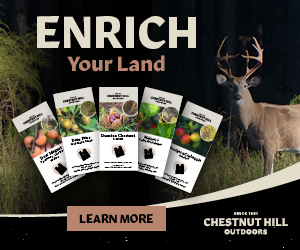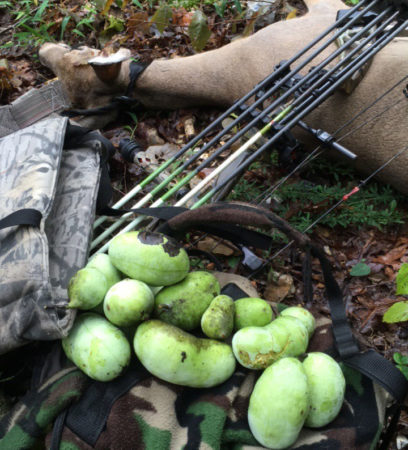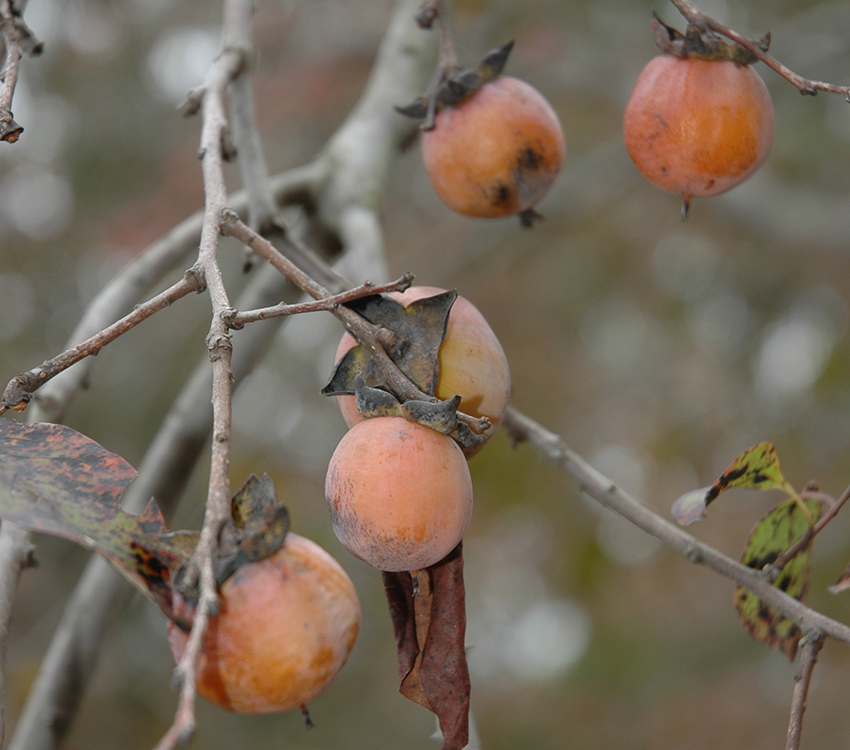Early hunting season can be a bountiful time in the deer woods if you do your homework, scout, and know where to place your stand or blind for a better shot opportunity. One of the best things you can do during this time is to target soft-mast species for your hunting setup. “Soft mast” is the general term for edible fruits and berries, and I have had some great hunting success over the years targeting early season soft mast.

Southeast
Persimmons – One of the most highly sought after soft-mast species for deer, persimmons are found all across the southeast. These sweet little orange fruits (photo above) are amazing deer attractants! Make sure you set up on a fruit bearing tree, as only the female trees bear fruit where the male trees do not. The male trees are still very important as they provide cross-pollination, so don’t cut them down just because they aren’t producing fruit!
Persimmons can be found growing in rocky, dry, open woods, edges of woods, glades, prairies, old fields, thickets, bottomland woods, valleys along streams or in moist, well-drained locations, including river bottoms. They are shade-tolerant trees but tend to produce more fruit in the sun.
Honorable mention: Muscadines / Wild Grapes – People love muscadines for jams, jellies, wines, and more! It’s not surprising they are a favorite of wildlife too, especially deer. They seem to thrive in the hot, humid weather conditions of the South in sunny locations with good air circulation. They are found on a climbing vine that has tendrils, often laced within the treetops. These delicious grapes ripen at the perfect time so watch for them to be ready and get set up for some early season success!
Northeast
Apples – If you ask deer hunters in the Northeast their go-to soft mast target species, you will overwhelmingly get the same response… apples. These may be from apple trees planted and cared for by you, or they may be on older trees remaining at old homestead sites or orchards that were planted by former occupants and settlers. Apples come in many different varieties and have different fruiting times depending on those varieties, which is something to be aware of when choosing which apple tree to set up on. Several of the northern states have hunting seasons that don’t start until most of the native soft-mast fruit is gone due to the colder temperatures. That’s why it can be to your advantage to hone in on the apple varieties that ripen in October for some early season success around these soft-mast hot spots.

A trail-camera caught this photo of a young buck eating apples from an old homestead tree in late September. Photo courtesy of NDA member Ray Purdy of New York.
Of course, apple trees that produce fruit need lots of sunlight, so look for them growing along field edges, in hedge rows, brushy areas and mid-successional forests. By keeping a close eye on a particular tree or groups of trees over time (successive years) you can get a feel for their relative drop dates.
Honorable Mention: Crabapples – Crabapples are well suited for the northern climate and many varieties can even hold their fruit well into the winter. They often grow in field edges, hedgerows, or even around old homesteads. NDA’s CEO, Nick Pinizzotto, said this about his hunting experiences with crabapples, “I’ve seen wild crabapple trees draw deer in like mosquitos to a bug light.” He also likes to plant crabapple trees where he hunts for future successes. A couple of his favorite varieties are Dolgo and Centennials.

Several species of native crabapples are found in multiple regions. This is the native southern crabapple of the Southeast.
Midwest
Pawpaws are often overlooked but are actually the largest edible native fruit in the United States. They taste sort of like a cross between a mango and a banana. Wildlife flock to these groves of trees that like to grow in creek bottoms in search of the amazing fragrant fruits. I have made it a point to bowhunt near pawpaws to fill some of my early season doe tags in an effort to balance the buck to doe ratio and reduce overpopulation where I hunt. It is one of my favorite times and places to hunt each season!

The author had early season success hunting deer that were feeding on pawpaws.
Honorable Mention: Persimmons – As stated earlier, persimmons are at the top of the list of favorable deer soft mast species. Not only are they found in the Southeast, but they are also found in the lower Midwest. They would be the top pick in the Midwest if found throughout the entire region. Bottom line: If you find a fruiting persimmon tree where you hunt, set up near it and wait for the action to begin once they get ripe!
NDA Deer Outreach Specialist Karli Gill uses persimmons for some helpful scouting by sticking ripe persimmons on the trunk of a tree or branch directly over her trail-camera so she can get a better up-close camera shot to help her in identifying the unique bucks where she hunts. She says it “also makes for some wonderful comedy of up-close deer pictures.”
Honorable Mention: Wild plums – Not only do wild plum trees drop some delicious fruits, the trees often grow in thick hedges or thickets and provide some amazing cover for deer as well. I’ve seen deer standing in a plum thicket in the middle of the day right next to a road without a care in the world because they were filling up on the tasty ripe fruits and cooling off in the shade.
West
Blackberries, dewberries, raspberries – There’s not really a clear favorite soft-mast producer for the entire Western region, but one type of soft mast that does span the entire range in the West are members of the Rubus species, better known as blackberries, dewberries, and raspberries. Whenever and wherever you can find these little drupelet berries that are still ripe during season, that would be a great place to start in your hunting endeavor. Oftentimes out West, hunters will glass a known feeding area for deer from a distance and setup accordingly for a shot. These “briar patches” are commonly one of those known areas
All brambles are thicket-forming perennials that act as biennials, and typically show up for the first time about two to three years after a disturbance. While they tolerate a broad range of soil types, the soil must be well-drained and grow best on sunny sites in sandy loam soil that is a little more acidic.
Honorable Mention: Huckleberries – Huckleberries are the state fruit of Idaho. These little purple fruits grow on shrubs that are right at a deer’s mouth level and are found in the higher elevations of the mountainous West. Huckleberries ripen in late summer, but the majority of Western states have deer seasons that start earlier than other states, so hunters might still be able to catch the small window of time when they’re ripe to cash in on a successful early season hunt.
Other Notable Species
I’ve mentioned just a couple of the top soft mast plants for each region, but don’t forget that there is a host of other great and highly desirable soft mast species all across the country that hunters can capitalize on including pears, pokeweed berries, chokecherries, American beautyberries, pin cherries, wild strawberries, late blueberries, rose hips, Saw palmetto berries, hawthorn berries, Dogwood berries, cherries, peaches, apricots, honey locust pods, sumac berries, Osage oranges, elderberries, Black Gum berries, berries from Viburnum species like highbush cranberries, nannyberries, squashberries, Possum haw berries, Rusty blackhaw berries, and more.
Become familiar with the soft mast producers in your area, do your homework, scout, and set up your stand or blind near one of these soft mast species when they’re ripe and you could be well on your way to some early season hunting success!
